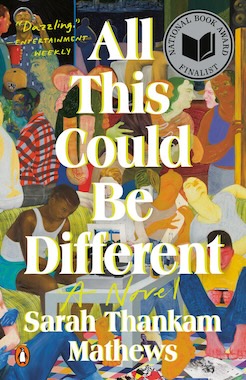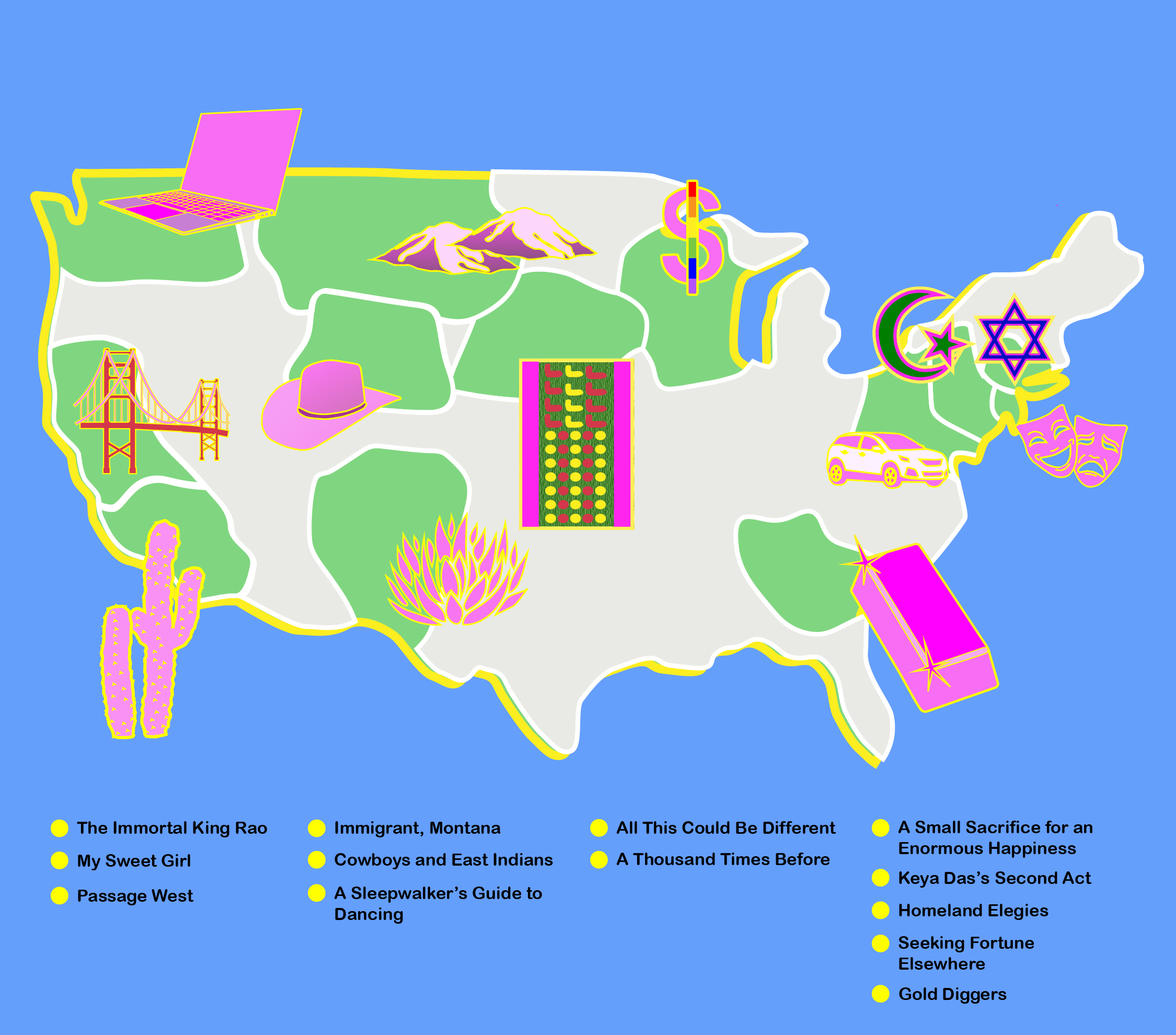Twenty-five years ago, Jhumpa Lahiri began publishing stories that offered America a rare glimpse into South Asian American lives. But Interpreter of Maladies and Lahiri’s other well-known early work represent only an opening into South Asian American stories. Lahiri and her contemporaries, including Chitra Banerjee Divakaruni and Bharati Mukherjee, were formative for spotlighting the community’s stories beginning in the 1970s and into the early 2000s. But narratives by and about South Asian Americans have since blossomed beyond the boundaries of Lahiri, Divakaruni, and Mukherjee’s work— and with it, the coastal states where their stories primarily take place: New Jersey, New York, Massachusetts, California. Today’s South Asian American literature has touched every corner of the United States, including Middle America, the Mountain West, the Pacific Northwest, and the South, transcending tales of economically privileged, well-educated Brahmin characters and chronicling the lives of queer, Dalit, biracial, and religious-minority South Asians—including those throughout history. South Asian American fiction today does not always center characters’ racial identities, either, but also tackles more universal plots and themes, such as alcoholism, mental illness, post-recession financial woes, and technological capitalism, in which the characters just happen to be South Asian.
Below is a literary map of South Asian America, spotlighting several works of fiction published after 2010 that take readers beyond a canon once confined to the coasts.
Laramie, Wyoming
Cowboys and East Indians by Nina McConigley
Tamil American author Nina McConigley takes readers on a journey across the American West in her short-story collection, focusing on the lives of Indian immigrants in her home state of Wyoming: her characters include motel owners, international students, interracial families, mothers with disabilities, and cross-dressing cowboys. Challenging the mythology of the Wild West and citing Laura Ingalls Wilder in the epigraph, McConigley, who hails from Casper, Wyo., expands the canonical voice of the prairie to spotlight the South Asians who have called the state home for decades. From her opening story, “Melting”: “We were the wrong kind of Indians living in Wyoming. There were Arapahoe, Shoshone, even some Crow. And then there was us.”
Seattle, Washington
The Immortal King Rao by Vauhini Vara
This dystopian-sci-fi-meets-diaspora novel, which was a finalist for the Pulitzer Prize, follows King Rao, a Telugu Dalit man raised by coconut farmers in rural South India, as he immigrates to the Seattle area for a computer science PhD. Years later, King Rao becomes the most powerful man in the world after founding a leading technology company, called Coconut. The Pacific Northwest has been home to South Asian Americans for more than a century, beginning with a group of Punjabi migrant workers in Bellingham, Washington who were driven out of the town by white residents in 1907. Now, the region, particularly Seattle, is known as a home for South Asians who work in technology at top global firms including Amazon and Microsoft. This book pays homage to these immigrants, their descendants, and their humble beginnings, and was followed by Vara’s short-story collection, This Is Salvaged.
Milwaukee, Wisconsin

All This Could Be Different by Sarah Thankam Mathews
Mathews’s debut novel, a finalist for the National Book Award, chronicles the life of a recent college graduate living in Milwaukee, Sneha, as she navigates her layered identities as a queer woman and as the only daughter of Indian immigrants, whom she hasn’t told about her sexuality. Loosely inspired by the author’s own life, the novel explores the repercussions of late-stage capitalism on struggling American 20-somethings in the Midwest as they navigate friendship, love, joblessness, drug abuse, and the specter of eviction. Although it centers on an Indian American woman, All This Could Be Different features a racially diverse cast of characters whose storylines don’t feel forced but rather blossom naturally in tandem with the protagonist’s complex arc.
Minneapolis, Minnesota
A Thousand Times Before by Asha Thanki
Thanki’s debut novel captures a multigenerational family shaped by the 1947 Partition and its bloodstained legacy. Featuring a queer couple at its center—and a queer ancestor and her forbidden lover in South Asia—the novel traces a tapestry that connects three generations of women as they navigate life in South Asia and America. Minneapolis features prominently as the narrator’s childhood home, representing the suburbs that South Asian immigrants have called home in America after leaving the subcontinent. “[My grandmother] was happy we had a place in a suburb, yes,” the narrator recalls, “but moving from New York to Minneapolis reminded her of what it had been like to leave Karachi—and now Karachi was nothing like she remembered, no, a whole different place that felt foreign.”
Scranton, Pennsylvania
Homeland Elegies by Ayad Akhtar
Akhtar, a Pakistani American writer, is from Brookfield, Wisconsin, a suburb of Milwaukee. His first novel, American Dervish, is set in the region and follows a Pakistani American boy who is conflicted about his identity, and Homeland Elegies features a narrator who is also from the Milwaukee area. But a key moment in the novel happens in Scranton, Pennsylvania, where the Pakistani American narrator is pulled over by a Pennsylvania state trooper and the two have a hostile interaction in which the narrator recognizes he must minimize his identity as a Muslim American of Pakistani descent in the aftermath of 9/11 to avoid making white authority figures uncomfortable.
Atlanta, Georgia
Gold Diggers by Sanjena Sathian
This debut novel combines magic realism with a diaspora story, following a pair of second-generation South Asian Americans originally from the Atlanta suburb of Hammond Creek, Georgia as they plan a heist to acquire a magical gold elixir that gives them an edge over their peers. It artfully pushes back on the model minority stereotype, exploring the academic and economic pressures faced by the children of affluent South Asian immigrants living in the suburbs—a landscape that has increasingly become home to blossoming South Asian American communities across the country, concentrated around America’s biggest cities. In doing so, it honors these immigrants’ hard work in cementing their place in this country, while painting an honest and refreshing portrait of the struggles they still face despite having achieved conventional success.
Pittsburgh, Pennsylvania
Seeking Fortune Elsewhere by Sindya Bhanoo
This short-story collection puts South Asian Americans in the driver’s seat as it takes readers on a journey spanning the country, from Eastern Washington state to Orlando to Pittsburgh, the author’s hometown. It reimagines the great American road trip, centering Indian immigrants—particularly, Tamil women—and their families as they traverse a range of landscapes to do what any American family would: attend weddings, reconnect with estranged relatives, and go on vacations they can’t afford. Bhanoo’s sophisticated prose offers a glimpse into the lives of South Indians—an underrepresented community within the corpus of South Asian American diaspora fiction—as they take ownership over their circumstances and refuse to succumb to stagnancy.
Albuquerque, New Mexico
The Sleepwalker’s Guide to Dancing by Mira Jacob
Jacob’s debut novel is partially set during a sweltering summer in the American Southwest and follows a religious Christian, South Indian family as they navigate their complicated past. The protagonist, Amina, is a photographer whose pursuit of art is a testament to the sacrifices her immigrant parents have made so she can follow her dreams. Amina returns home to Albuquerque to be with her parents when her father falls ill and reflects on the family’s history while dealing with her own career crisis as a 30-year-old. Through its Southwestern setting and Christian characters, the novel decenters narratives of South Asians as Hindu immigrants living along the coasts. More recently, Jacob published a graphic memoir, Good Talk.
Emigrant, Montana
Immigrant, Montana by Amitava Kumar
“There was nothing here for me,” Kailash, the protagonist in Kumar’s novel, reflects when he retraces a trip he and his ex-girlfriend took to Yellowstone National Park. A town near the park is called Emigrant, Montana, from which the book’s title takes its name when Kailash calls it Immigrant, Montana. The town’s name is aspirational: “it was a name that I had long carried in my imagination […] it was a name that brought together […] the two most deeply felt needs of mine, the desire for love and the hankering for home,” he reflects. Even though it is just a name, and the Rocky Mountain setting itself features only momentarily in the novel, the Montana town symbolizes Kailash’s deepest desires: to discover a sense of home in an unfamiliar land. Instead, he finds emptiness.
Imperial Valley, California
Passage West by Rishi Reddi
This work of historical fiction portrays the lives of early 20th-century Punjabi farmworkers in the Imperial Valley as they deal with racism, xenophobia, and violence. Offering readers a slice of little-known American history, including California’s Alien Land Laws and its Punjabi-Mexican community, Reddi’s novel underscores the long presence of South Asians in America, decades before the 1965 Immigration and Nationality Act opened the doors to mass immigration from the Indian subcontinent. The debut novel follows Reddi’s Karma and Other Stories, a short-story collection set mostly in the Boston area.
San Francisco, California
My Sweet Girl by Amanda Jayatissa
Jayatissa’s debut novel traces the life of Paloma, a Sri Lankan adoptee living in San Francisco, who struggles with mental illness and alcohol abuse as she tries to make a living as a freelance graphic designer. After discovering her Indian American roommate, Arun, murdered on the kitchen floor of their apartment, Paloma attempts to pick up the pieces while steering the novel’s thrilling plot as an unreliable, unlikeable narrator. Toggling between Paloma’s childhood in a Sri Lankan orphanage and her present life in San Francisco, My Sweet Girl navigates Paloma’s identity crisis as a transracial adoptee who feels like an “other” in every space she inhabits.
Brooklyn, New York
A Small Sacrifice for an Enormous Happiness by Jai Chakrabarti
With stories set in India and New York, Chakrabarti’s debut collection explores the convergences between Indian and Jewish communities in Brooklyn, including through stories about an Indian widow engaged to a Jewish man and an Indian immigrant nanny who cares for the son of a biracial couple. Chakrabarti, who won the National Jewish Book Award for his novel, A Play for the End of the World, artfully ties together stories about the two communities, revealing their unlikely intersections in one of America’s most ethnically diverse, and its most populous, city.
Suburban New Jersey
Keya Das’s Second Act by Sopan Deb
Deb’s debut novel follows the fractured Bengali American Das family as they stage a play written by their teenaged daughter, Keya, after she passes away in a car accident. Keya was queer and hadn’t come out to her parents before she died. Bringing Keya’s friends and former girlfriend, Pamela, together with his own family, Keya’s divorced father, Shantanu, decides to stage the play in her memory. The novel brings together the universal themes of mental health and grief in what Deb calls an “all-American story,” in which the ethnicity of the characters is simply incidental, rather than formative, to the plot. Deb has also published a memoir, Missed Translations, that explores his difficult relationship with his Bengali immigrant parents.
About the Illustrator
Nuri Bhuiyan is a multimedia digital and spatial designer. Working at the juncture of visual and experiential storytelling, she captures large-scale social and environmental challenges and their origins in, impacts on, and adjacencies to personal life, culture, and community. She received a B.A. in the History of Art and Architecture at Harvard University and professionally practices architecture and branding. She is currently pursuing several creative projects, which she can often be found doing in a cafe in Brooklyn, where she is based.Her work can be found on Instagram @madebynauri and on her website at https://bit.ly/nuribhuiyan.






